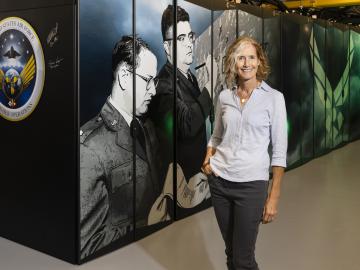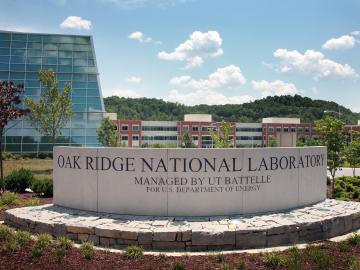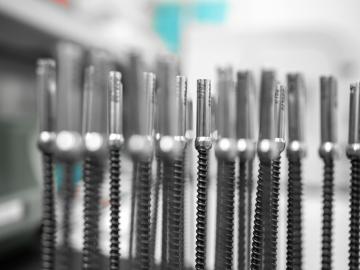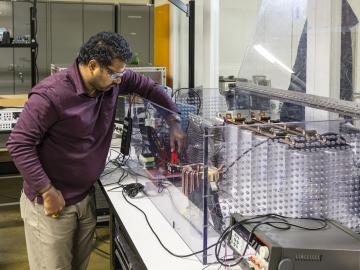
Filter News
Area of Research
- Advanced Manufacturing (1)
- Biology and Environment (8)
- Building Technologies (1)
- Computational Biology (1)
- Computational Engineering (2)
- Computer Science (4)
- Electricity and Smart Grid (1)
- Energy Science (14)
- Fusion and Fission (2)
- Isotopes (13)
- Materials (9)
- Materials for Computing (7)
- Mathematics (1)
- National Security (3)
- Neutron Science (7)
- Quantum information Science (2)
- Sensors and Controls (1)
- Supercomputing (17)
News Topics
- (-) Computer Science (76)
- (-) Cybersecurity (5)
- (-) Grid (26)
- (-) Isotopes (29)
- (-) Machine Learning (24)
- (-) Mercury (3)
- (-) Nanotechnology (12)
- (-) Physics (12)
- (-) Space Exploration (7)
- 3-D Printing/Advanced Manufacturing (56)
- Advanced Reactors (7)
- Artificial Intelligence (52)
- Big Data (33)
- Bioenergy (29)
- Biology (45)
- Biomedical (23)
- Biotechnology (15)
- Buildings (42)
- Chemical Sciences (37)
- Clean Water (14)
- Composites (17)
- Coronavirus (10)
- Critical Materials (11)
- Education (2)
- Emergency (3)
- Energy Storage (36)
- Environment (77)
- Exascale Computing (27)
- Fossil Energy (4)
- Frontier (25)
- Fusion (20)
- High-Performance Computing (64)
- Hydropower (1)
- ITER (6)
- Materials (56)
- Materials Science (48)
- Mathematics (8)
- Microelectronics (2)
- Microscopy (14)
- Molten Salt (1)
- National Security (41)
- Neutron Science (43)
- Nuclear Energy (21)
- Partnerships (29)
- Polymers (10)
- Quantum Computing (25)
- Quantum Science (34)
- Security (11)
- Simulation (24)
- Statistics (4)
- Summit (23)
- Transportation (36)
Media Contacts
The United States could triple its current bioeconomy by producing more than 1 billion tons per year of plant-based biomass for renewable fuels, while meeting projected demands for food, feed, fiber, conventional forest products and exports, according to the DOE’s latest Billion-Ton Report led by ORNL.

An experiment by researchers at the Department of Energy’s Oak Ridge National Laboratory demonstrated advanced quantum-based cybersecurity can be realized in a deployed fiber link.

Kate Evans, director for the Computational Sciences and Engineering Division at ORNL, has been awarded the 2024 Society for Industrial and Applied Mathematicians Activity Group on Mathematics of Planet Earth Prize.

Anuj J. Kapadia, who heads the Advanced Computing Methods for Health Sciences Section at ORNL, has been elected as president of the Southeastern Chapter of the American Association of Physicists in Medicine.

Since 2019, a team of NASA scientists and their partners have been using NASA’s FUN3D software on supercomputers located at the Department of Energy’s Oak Ridge Leadership Computing Facility to conduct computational fluid dynamics simulations of a human-scale Mars lander. The team’s ongoing research project is a first step in determining how to safely land a vehicle with humans onboard onto the surface of Mars.

Two different teams that included Oak Ridge National Laboratory employees were honored Feb. 20 with Secretary’s Honor Achievement Awards from the Department of Energy. This is DOE's highest form of employee recognition.

To capitalize on AI and researcher strengths, scientists developed a human-AI collaboration recommender system for improved experimentation performance.

Pablo Moriano, a research scientist in the Computer Science and Mathematics Division at ORNL, was selected as a member of the 2024 Class of MGB-SIAM Early Career Fellows.

A key industrial isotope, iridium-192, has not been produced in the U.S. in almost 20 years. DOE's Isotope Program and QSA Global Inc. announced a joint product development agreement to initiate U.S. production of iridium-192.

Scientists at ORNL are looking for a happy medium to enable the grid of the future, filling a gap between high and low voltages for power electronics technology that underpins the modern U.S. electric grid.


